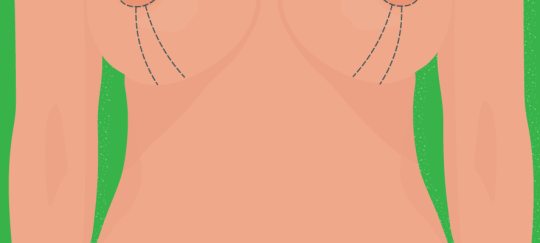What To Know Before Getting A Boob Job
So, you’re thinking of having your boobs done. But, like buying your first apartment or searching for a new job, any type of breast surgery requires careful consideration, research, and a basic understanding of what’s involved — even before booking your first appointment with your surgeon.
Related: This Is NOT Why Taylor and Calvin Broke Up
For example, what’s the difference between a breast augmentation (“boob job”) and a lift? What does a reduction entail? How do you go about finding the right doctor for you? To answer all of your burning questions, we consulted four surgeons who practice in different areas of the country for their insider, on-the-ground, and no-BS advice on what to know before even thinking about doing anything to your boobs.

Illustrations by Anna Sudit.
First things first: Do a little homework.
While an indiscriminate Google search on boob jobs, lifts, or reductions will probably take you down a rabbit hole of overwhelming (and sometimes dubious) information, focused initial research is crucial.
Related: How To Make Your Eyes Look HUGE
The two most comprehensive and, more importantly, plastic-surgeon vetted and recommended sites are the American Society of Plastic Surgeons and the American Society for Aesthetic Plastic Surgery. Both these resources break down the different types of breast surgeries available and procedure details, provide info on FDA-approved implants, explain the costs, and give crucial updates on the latest related news and technologies.
Related: What Going Paleo Did To My Body
“Any woman thinking about breast augmentation, or any cosmetic breast work, should look at both of those sites,” says Julius Few, MD, founder of The Few Institute of Aesthetic Plastic Surgery, which has locations in Chicago and New York. The institute offers listings of plastic surgeons in your area who specialize in breast-related procedures.
Shop around: Find the right doctor.
Selecting the right surgeon is the most important part of this process. First, you need to make sure your doctor is legit, i.e. certified by the American Board of Plastic Surgery. Don’t be confused by a certification from the American Board of Cosmetic Surgery, which, per Los Angeles surgeon
, MD, is “not plastic surgery.” Larry Fan, MD, founder of
in San Francisco, agrees by pointing out that plastic surgeons are specifically educated, trained, and certified to perform both cosmetic and reconstructive surgeries of the entire face and body.
Related: This Is What Female-Directed Porn Looks Like
Also, beware of any other official-sounding, but totally sketchy “board” or “association.” It’s actually legal for other types of surgeons, and even non-surgeons — ear, nose, and throat doctors; Ob/Gyns; physical therapists; and dermatologists — to perform cosmetic surgery on your breasts, even though it’s not their specialty. Dr. Fan strongly suggests verifying a doctor’s plastic surgery board certification with the American Board of Medical Specialties at Certification Matters. And, make sure to ask how many years of training and practice the doctor lists on his or her résumé. It’s also a good idea to verify the surgeon’s hospital privileges, and make sure the surgical facility and office are accredited by a national- or state-recognized agency.
Once you feel safe and secure with your decision, make sure you connect with your doctor. “It’s important to try to get a sense of whether or not your aesthetic sense is aligned with the surgeon’s,” says Mia Talmor, MD, plastic surgeon at New York-Presbyterian Hospital (and the first female surgeon appointed to the full-time faculty of the Division of Plastic Surgery at the hospital: respect). Referrals from a trusted friend are great, too. Sometimes, Dr. Talmor will have her prospective patients meet with current ones to feel more at ease with their decision.
Related: Glow International With These Asian Beauty Products
The surgeon should also schedule two consultation appointments with you prior to the surgery — the first to talk things out, and the second to go over preoperative decisions — and maintain regular follow-ups after your procedure.
Ask to see as many photos of their work as possible.
Photos — or “aesthetic ideals,” in Dr. Kao’s fancy surgical terminology — not only help you determine if your visions match, but also to convey to your doctor what size and shape you want your boobs to end up. All the doctors we spoke with say that the way bra sizes, cup sizes, and implant volumes look on each individual’s body differs. Even a 3-D camera, while hi-tech and cool-looking, won’t always be accurate. Dr. Few uses one for research, but thinks the digital generation sets up “unrealistic expectations.” He has patients look at up to 50 photos — specific sizes, shapes, and skin tones — of “befores” similar to the patient and preferred “afters” to best represent end goals.
Also, crucial: Pictures provide the opportunity to assess the doctor’s surgical skill when it comes to post-surgery scars. Because, there will be scarring (much more on that below), so you need to meticulously assess and compare as many photos of the surgeon’s handiwork as possible. “You want to see 10, 20, 30, 40 really, really good [examples of] work,” Dr. Kao emphasizes.
Make sure they’re FDA-approved (duh).
You may have come across miraculous-sounding, en vogue implants like B-Lite from Britain. But, it’s safest to stick with ones approved by the FDA. Dr. Talmor says that there are only three FDA-approved implant-manufacturing companies in the U.S.: Mentor, Allergan, and Sientra. “The FDA process here is pretty stringent,” she says. “They…review all the data from the implant companies to determine if the implant is safe for use, so it’s a pretty good idea to use one of those three approved manufacturers.”

Understand the different types of implants.
Once you decide on your aesthetic goal, your surgeon will work with you to decide what implants will help you achieve it. Here’s a primer on the terminology you’ll be hearing:
You may have heard of saline implants, which are filled with sterile salt water (and are FDA-approved for those 18 and up) and silicone implants, which are filled with silicone gel (and are approved for ages 22 and older). Dr. Few says that silicone implants are the most common type in the U.S. and internationally, because they’re softer and give a more natural look — plus they’re less likely to break. Dr. Kao, who hasn’t done a saline implant in 12 years, agrees, and points out that the saline kind can create an awkward rippling effect under the skin.
Related: The Beauty Emoji We REALLY Need
Know that implants come in different profiles (i.e., heights) and in round or teardrop shapes, and can be smooth or textured. Talk to your doctor about what you want your breasts to look and feel like.
Understand the different incision sites for implant insertion.
The surgeon has to create a pocket — either over or under your pectoral muscle — to insert the implant. There are
for making the incision (and where you could have scars). The surgeon’s recommended approach depends on the size of the implant and your own anatomy. So, definitely ask your doctor about what type of scar will result after your augmentation, reduction, and/or lift. It can also depend on your skin quality: For example, stretch-marked or less elastic skin is more scar-prone.
One approach is the periareolar way, which means the incision goes around the lower half of the nipple. Dr. Kao prefers this method because the eventual scar can blend in with the nipple. Plus, he says the nipple is “usually covered up” (although tell that to #freethenipple supporters). There’s the inframammary incision, which goes under the crease of the breast. Dr. Few says this technique is favored for women who tend to sag more in the lower half of the breast, so the scar is completely hidden. There’s also the transaxillary incision, which is in the armpit. This approach appeals to women with small areolas and not enough breast tissue to hide an inframammary scar. Dr. Fan specializes in this technique, which is typically more difficult to perform, by using an endoscope for more precise implant placement.
There’s also a fourth approach called TUBA (short for transumbilical breast augmentation), which goes in through the bellybutton and is for saline implants only. While some surgeons do specialize in TUBA, it’s not as popular. Dr. Fan says there’s a higher risk of mispositioning of the implants and excessive scar-tissue forming (a.k.a. capsular contracture).
And, about that fat-transfer boob job.
A fat-transfer breast augmentation entails liposuctioning fat out of one part of the body and injecting it into the breasts. The doctors we talked to are divided on the topic. First off, it really only gives a moderate increase in breast size. But also, the patient needs to have enough fat to remove. Dr. Kao says that 90% of his breast work involves some form of fat transfer, and he uses a process called centrifugation to “purify” the fat. He points out that he needs to remove about three times as much fat as he needs to inject.
“[Fat transfer] is still considered somewhat investigational, particularly in the setting of breast augmentation without the use of an implant,” says Dr. Talmor. She only uses fat transfer to support breast reconstruction surgery along with an implant, not for cosmetic augmentation. Dr. Few acknowledges that the process is still “controversial,” and he does not perform it because he’s waiting for more data on its long-term impact. He says that while the procedure is natural because it uses your own body’s fat and fluids sans synthetic foreign bodies, there are a few caveats. The first is aesthetic: Without an actual solid implant, fat itself can’t do any “lifting” to help sagging. Also, “there is a real chance of a significant portion of the fat transfer being absorbed by the body,” which can make the results look non-ideal.
For more on what to expect, visit Refinery29.
By: Fawnia Soo Hoo
